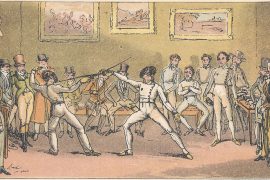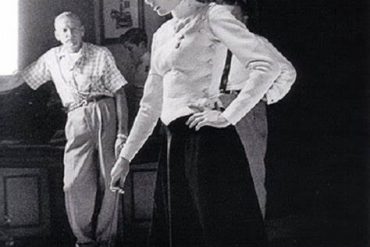I often get the question if it is possible to learn historical fencing without a group. It’s usually followed by the statement that there is ‘no one nearby that does historical fencing’. So, what do you do when you’re all alone and want to learn swordsmanship?
This is a complicated question, with many answers and paths. But with enough desire and work ethic, nearly anything is possible. With that said, there are degrees of difficulty and, of course, the currency of time. Time is something people often undervalue, thinking it is infinite and free, when it is neither. Just for fun, we will compare difficulty levels in learning these arts like it’s a popular video game. But first, we will talk about the gear you will need.
Gear up (ie Retail Therapy)
Who doesn’t like buying a new sword? Crazy people, that’s who. Regardless of your level of skill, it’s advisable to visit an online retailer and buy some essential equipment. At the very least, you will need a synthetic sword.
If you are in the US, Purpleheart Armory is, in my opinion, the #1 choice. They have it all and are geared towards HEMA in all its forms.
In Canada, that distinction belongs to Dark Age Creations, who import and stock a wide variety of training gear. The up and coming Sword Gear is an excellent source for Kvetun and Superior Fencing equipment.
In Europe, you can order synthetics from Black Fencer directly, and of course, for protective gear reputable companies like SPES, St Mark, and PBT. There are also many good feder options for when you are ready to spar. My recommendation is Ensifer (based in Poland) as the quality and durability of these blades are still the standard after almost a decade. Jan also ships to a variety of countries, which is nice.
These companies are all run by good people who are serious about swordsmanship and provide quality training gear.
Recommended starting solo gear:
- Pair of training synthetic swords. The Purpleheart armory or Blackfencer synthetics are the best options. I recommend you buy two because eventually, you will not train alone.
- Pell for solo training Check out: https://www.youtube.com/watch?v=wpzEox5TDzw
- Note: You can use a stick, but it’s not ideal for long term practice.
Recommended solo exercises:
Regardless of what path you choose to take, the following are always staples of well-rounded solo practice.
- Pell work – https://www.youtube.com/watch?v=smWC5zcdhCk
- Solo forms – https://www.youtube.com/watch?v=POuAddaVSZM&t=212s
- Strength and conditioning – https://www.youtube.com/watch?v=C3ydCfoqIBM
- Mirror work/Shadow boxing (https://www.youtube.com/watch?v=i12A6G_LiJo) Note: You can easily adapt boxing exercises like this one, for at home free flow sword practice.
- Reviewing sparring/tournament footage (your own, and others)
- Movement/footwork drills
Ready to play? Choose your difficulty level…
Now that you have your gear, you have a few sample exercises, you are invested, and you are willing to learn… how hard a difficulty level will you choose?
Hard
Do you love a nearly impossible challenge? Well, then you will love this way of doing things, as it will bring you back to the late 90’s and early 2000’s.
You buy a translation, or for bonus points, translate a digital scan yourself, and pour through the manuscripts. Figure out the techniques from reading and contrasting with the pictures within. You can find many of these for free on the internet, translation quality varies, and many of the better translations are available for purchase at a moderate price.
Once you kind of have a handle on it, find a training partner as obsessive as you, and continue refining your techniques until you think they are adequate. Then eventually test your skills in a variety of tournaments that are within reasonable travelling distance.
This is undoubtedly the hardest way to learn these arts, and is mainly unnecessary considering the vast amount of resources available to you now. But it’s the old school way to do it.
Medium Difficulty
Maybe you come from another martial arts background. That can be a double-edged sword (pun intended). In some ways, you may have an advantage, but in others, you may not. In general, most people coming into this from a combat sport or performance level contact sport, combined with coaching training, will certainly possess an advantage when they start.
I have found through experience that people coming from wrestling programs, football, hockey, and other contact-heavy sports and martial arts tend to have distinct advantages when learning historical fencing arts. Generally speaking, they have a greater degree of discipline and physical self-awareness.
If you are coming into historical fencing from such a background, you may also have skilled training partners with which you can work. Or perhaps a group of friends who could be interested if you asked them.
From there, you should get translations of the manuscripts and contrast them with some of the better free video resources out there. You can also buy some of the more detailed video resources for your collection and attend a few seminars here and there.
However, as with all things, it is buyer beware. Not all of the resources – free or paid – are good, and any mistakes you make on this will cost you training time. For example, I have a few things on my shelf and in my armory, I felt suitable investments when I was new. But looking back, they did not pay dividends.
Easy Mode
Technological improvements and the pandemic have led to more live Zoom classes and other online courses popping up. So, nowadays, you now can try out a variety of live online class programs through Zoom and select an instructor who connects with you and your needs the best. Some classes are monthly, and others are one-off seminars.
Although this is the most expensive option, a good program with an experienced instructor, will drastically reduce your time to being a proficient swordfighter.
Thanks to modern technology, learning this art doesn’t have to be hard. It also doesn’t have to be so time-consuming that your work-life balance suffers. And remember, time is a commodity, like money. Today there are many options available for you to learn HEMA in a style that you feel suits you best, from a person or group of people with whom you connect.
Despite the advantages of training with a knowledgeable resource via an online medium, I will give you one important caveat when selecting an instructor: Avoid those who boast of fancy ‘master’/’maestro’ titles or throw around the word repetitively as a cheesy marketing schtick. The stark reality is that there are precisely zero legitimate masters anywhere in Historical fencing. It is critical to understand that these traditions are part of a set of broken lineages, and this art is still in its reconstruction and will be for the foreseeable future. I will delve into the great master debate in a future article, but for now, you can check out Anders and Axel’s podcast to the master topic here
All these options are great, so what path do I take?
Only you can answer this question for yourself. It’s your path, after all, but I recommend that you take advantage of the online resources and courses.
As with most pursuits in life, it comes down to time, money, and effort. Just understand that 15 years ago, this space was different. It was, frankly speaking, the Wild West and you didn’t have much choice. If you didn’t have someone with a few skills in driving distance, you had to figure it out yourself, recruit your own training partners, and then fly to a couple of events a few times a year to take classes and see if your interpretations worked against an unwilling opponent.
The technology simply was not there to contact and learn from skilled instructors in real-time, and schools were too few and too far between. The advantage of learning over Zoom is that you get real feedback and guidance in a virtual classroom. Today there is a growing level of educational infrastructure, and quality of instructional books as well as a growing number of videos on a variety of topics. Quality equipment is aslo more accessible than ever, and it’s comparatively rare to have excessively long waits for a decent training sword, feder or jacket.
So, if you are new, or even an experienced practitioner just looking to improve your skills but have no means of travel right now, be happy and know that you are fortunate. In 2021, there are a lot of resources and ways of achieving your training goals that many of us simply did not have a decade ago.
My final advice to you is to always weigh out your decision carefully, commit to your path, and choose the best option that you can afford.
About Lee Smith
Lee Smith is the founder of Blood and Iron Martial Arts. He is an accomplished competitive fencer and experienced instructor who along with his students has fought and taught at seminars and events across the globe. Over his career he has trained several of the top fighters and instructors in Canada, and together with his wife Nicole, they have taught countless more through their popular Youtube channel. Currently Blood and Iron has three club chapters in Canada, and one in Silver City New Mexico along with some upcoming international affiliates. They have a growing online training program with students across three continents.
Check them out here:
Website: http://www.bloodandiron.com
Online training program: www.bloodandiron.ca/online
Youtube channel: https://www.youtube.com/c/BloodandIronHEMA




